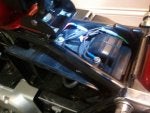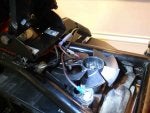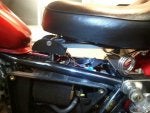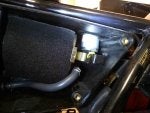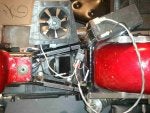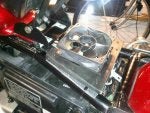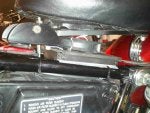The Rebel electric Supercharger
This thread is an off shoot of "The Performance Challenge". There was some good debate, mostly negative, about the difficulty of improving Rebel performance and the limits of the electrical system. Some excellent electrical specifications were also provided. I will be using a separate rechargeable battery system to power this supercharger and figure out the best charging options later
I decided to use a DC electric drill motor and the fan blades from a computer power supply. It was not difficult mating them together. With the fan blades attached, the motor draws 10 amps at 12 volts and blows a good volume of air pretty hard. I will be barrowing an air flow meter to determine its actual output and how well it will match up with the Rebel intake needs.
The first picture shows the motor assembly followed by a view of the stock air intake on my 1985 rebel.
Next picture is a top view on how I intend to position the motor. I will be fabricating a custome housing around it. There are then side views showing the motor extending into the housing. The opening into the air box will have to be expanded but the plastic is easy to work with. The raised spring seat works great with this project.
As I explained the in Performance Challenge thread, I will be racing the engine this weekend recording performance with the Android app "Racing Tester" which I will publish here. I will then be installing the Supercharger and testing again to record performance changes.
This thread is an off shoot of "The Performance Challenge". There was some good debate, mostly negative, about the difficulty of improving Rebel performance and the limits of the electrical system. Some excellent electrical specifications were also provided. I will be using a separate rechargeable battery system to power this supercharger and figure out the best charging options later
I decided to use a DC electric drill motor and the fan blades from a computer power supply. It was not difficult mating them together. With the fan blades attached, the motor draws 10 amps at 12 volts and blows a good volume of air pretty hard. I will be barrowing an air flow meter to determine its actual output and how well it will match up with the Rebel intake needs.
The first picture shows the motor assembly followed by a view of the stock air intake on my 1985 rebel.
Next picture is a top view on how I intend to position the motor. I will be fabricating a custome housing around it. There are then side views showing the motor extending into the housing. The opening into the air box will have to be expanded but the plastic is easy to work with. The raised spring seat works great with this project.
As I explained the in Performance Challenge thread, I will be racing the engine this weekend recording performance with the Android app "Racing Tester" which I will publish here. I will then be installing the Supercharger and testing again to record performance changes.



